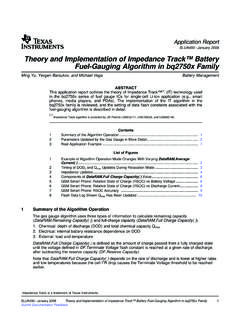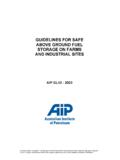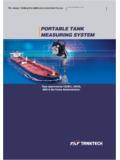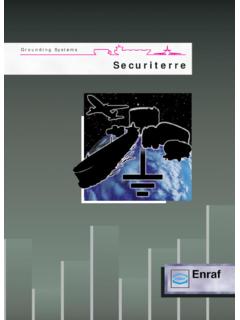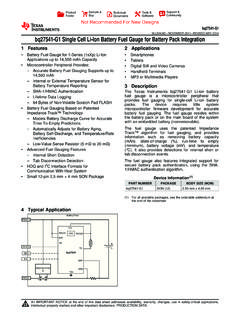Transcription of Corrosion in Systems Storing and Dispensing Ultra …
1 Contract No. CON00008697. Study No 10001550. Final Report Corrosion in Systems Storing and Dispensing Ultra Low Sulfur Diesel (ULSD), Hypotheses Investigation Battelle Memorial Institute 505 King Avenue Columbus, OH 43201. To Clean Diesel fuel Alliance C/O Mr. Prentiss Searles American Petroleum Institute 1220 L Street, NW. Washington, DC 20005-4070. September 5, 2012. (Page intentionally left blank). Corrosion in Systems Storing and Dispensing Ultra Low Sulfur Diesel (ULSD), Hypotheses Investigation Final Report Battelle does not engage in research for advertising, sales promotion, or endorsement of our clients'. interests including raising investment capital or recommending investments decisions, or other publicity purposes, or for any use in litigation.
2 Battelle endeavors at all times to produce work of the highest quality, consistent with our contract commitments. However, because of the research and/or experimental nature of this work the client undertakes the sole responsibility for the consequence of any use or misuse of, or inability to use, any information, apparatus, process or result obtained from Battelle, and Battelle, its employees, officers, or Trustees have no legal liability for the accuracy, adequacy, or efficacy thereof. (Page intentionally left blank). Table of Contents ACRONYMS AND ABBREVIATIONS .. v Executive Summary .. 1. 1. Introduction and Background .. 3. 2. Objective .. 4. 3. Working Hypotheses .. 5. 4. Experimental Methods .. 5. Inspection Site Identification .. 6. Inspection Procedure and Sample Handling.
3 7. Sample 7. Biological Analysis 8. DNA Extraction .. 8. Sequencing .. 9. Whole Genome Amplification .. 9. 16S rRNA Gene Analysis .. 9. 9. Diversity Analysis .. 10. Chemical Analysis Methods .. 10. Additives Hypothesis Investigation 11. 5. 12. Inspection Site 12. Biological Sample Results .. 12. DNA Yield and Amplification Results .. 12. Dominant Organisms by Site .. 14. Hydrocarbon Degrading Bacteria .. 15. Diversity Assessment .. 16. Chemical Analyses Results .. 17. Corrosion Sample Results .. 20. Additives .. 20. Quality Assurance/Quality Control .. 21. 6. Discussion .. 21. Corrosion Inducing Factors .. 21. UST Equipment Materials .. 21. Ingredients for an aggressive corrosive electrolyte .. 22. Electrolyte Distribution .. 23. Microbial 24. Hypotheses Evaluations.
4 26. Additive Hypothesis Evaluation .. 26. Chemical Species Hypothesis Evaluation .. 28. Microbial Hypothesis 30. 7. 32. 8. 35. September 2012 iii Page Appendix A Phase 1 Hypothesis Evaluation Table .. A-1. Appendix B Inspection and Sample Handling Protocol .. B-1. Appendix C Sample Information and Site Inspection Field Data .. C-1. Appendix D Sequencing Supplementary D-1. Appendix E Characteristics of Dominant Identified Organisms .. E-1. Appendix F Chemical Analysis Results of Water Bottoms, fuel , and Vapor Samples .. F-1. Appendix G Corrosion Discussion and Chemical Analysis Results of Bottom Sediments and ScrapingsG-1. List of Figures Figure 1. Corroded ULSD equipment: Corroded carbon steel submersible turbine pump (STP) shaft removed from pump housing (left), brass ball float extractor cage plug (middle), aluminum drop tube (right).
5 3. Figure 2. Additives Hypothesis Evaluation .. 27. Figure 3. Aggressive Chemical Species Hypothesis Evaluation .. 29. Figure 4. MIC Hypothesis Evaluation .. 31. Figure 5. Final Hypothesis .. 34. List of Tables Table 1. Sample Collection and Handling .. 8. Table 2. Analysis Methods by Sample Type .. 11. Table 3. Inspection Site Characteristics .. 12. Table 4. DNA Yield, Whole Genome Amplification and 16s rRNA Amplification .. 13. Table 5. Dominant Organisms by Site .. 15. Table 6. Identified Organisms According to Oxygen Needs .. 15. Table 7. Percent of DNA Identified for Selected Hydrocarbon Degrading Bacteria .. 16. Table 8. Diversity Assessment .. 16. Table 9. Summary of fuel Sample Results .. 17. Table 10. Summary of Water Bottom Sample Results .. 18.
6 Table 11. Summary of Vapor Sample Results .. 20. Table 12. Summary of Acetic Acid/Acetate and Ethanol Concentrations in UST Systems Inspected .. 23. September 2012 iv ACRONYMS AND ABBREVIATIONS. ASTM ASTM International ATG automatic tank gauging bp base pair CDFA Clean Diesel fuel Alliance DNA deoxyribonucleic acid EPA Environmental Protection Agency GC-MS gas chromatography-mass spectrometry IC ion chromatography ICP-MS inductively-coupled plasma mass spectrometry LSD low sulfur diesel MIC microbial influenced Corrosion NCH Nationwide Children's Hospital PCR polymerase chain reaction PEI Petroleum Equipment Institute ppm parts per million QA quality assurance QAPP Quality Assurance Project Plan QC quality control SOP standard operating procedure STI Steel Tank Institute STP submersible turbine pump TAN total acid number taxID taxonomic identification ULSD Ultra low sulfur diesel UST underground storage tank UV ultraviolet WGA whole genome
7 Amplification XRD x-ray diffraction XRF x-ray fluorescence September 2012 v (Page intentionally left blank). September 2012 vi Corrosion in Systems Storing and Dispensing Ultra Low Sulfur Diesel (ULSD), Hypotheses Investigation Final Report Executive Summary Severe and rapid Corrosion has been observed in Systems Storing and Dispensing Ultra low sulfur diesel (ULSD) since 2007. In addition, the Corrosion is coating the majority of metallic equipment in both the wetted and unwetted portions of ULSD underground storage tanks (USTs). To investigate the problem in an objective manner, multiple stakeholders in the diesel industry, through the Clean Diesel fuel Alliance, funded this research project. The design included the identification of retail fueling sites and the development of an inspection and sampling protocol to ensure uniform and thorough inspections of USTs.
8 fuel , water bottoms, vapor, bottom sediments, and scrape samples were taken from six sites: one that was not supposed to have symptoms (but did to a much lesser degree) and five that were to have the severe Corrosion . Then, samples from the inspections were analyzed for genetic material and chemical characteristics. These data, in combination with information on additives, have allowed Battelle to draw conclusions with respect to three working hypotheses. Specifically, the hypotheses are: 1) Aerobic and anaerobic microbes are producing by-products that are establishing a corrosive environment in ULSD Systems ;. 2) Aggressive chemical specie(s) ( , acetic acid) present in ULSD Systems is(are). facilitating aggressive Corrosion ; and 3) Additives in the fuel are contributing to the corrosive environment in ULSD Systems .
9 All of the sites inspected contained microbes, although at different abundances. The dominant organism identified from three of the sites, Acetobacter, has characteristics pertinent to the Corrosion observed in all of the sites, such as acetic acid production, ethanol utilization, low pH. requirements, and oxygen. Although geographically on opposite sides of the country, from different fuel suppliers, and of relatively new construction materials, the presence of the organisms was relatively uniform. The traditionally expected hydrocarbon degrading organisms were found in insignificant abundances. This indicates that the inspected ULSD USTs are selective environments for these specialized, acetic acid producing organisms. Of note from the chemical analyses is that acetic acid was found to be ubiquitous (water bottoms, fuel , vapor, and scrapings) in all of the sites inspected.
10 In addition, ethanol was unexpectedly identified and measured at five of the six sites. Components necessary for the organisms identified to proliferate were analytically determined to be present in the majority of the samples: trace amounts of ethanol, low pH, oxygen, and water were present in the diesel USTs inspected. Finally, although additives could play a role in the corrosive environment, it is unlikely that they are the primary cause of the observed Corrosion . September 2012 1. This project was designed to objectively investigate multiple hypotheses as to why ULSD USTs have been experiencing severe and rapid Corrosion . The in-depth site inspections were performed on a limited number of sites and therefore may not be representative all of Systems experiencing this phenomenon.

